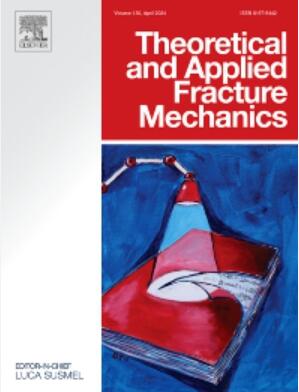层理取向和加载速率对煤断裂行为的影响:实验分析
IF 5.6
2区 工程技术
Q1 ENGINEERING, MECHANICAL
引用次数: 0
摘要
为了探索煤的断裂行为,在室内对具有不同预裂倾角和层理方向的半圆形弯曲试样分别进行了准静态和动态加载试验。考虑层理分布,将煤视为横向各向同性介质,其弹性特性由单轴压缩试验得出。采用实验-数值方法确定了临界应力强度因子。结果表明,临界应力强度因子的变化受预裂倾角、层理取向和加载速率的共同影响。随着层理角度的增大,层理与加载方向的平面位置关系由正交状态逐渐演变为平行状态,临界应力强度因子随着层理内部胶结强度的降低而下降。在预裂纹旋转过程中,由于角数有限,且各向异性较强,其变化无明显的规律性。煤的临界应力强度因子对加载速率敏感,随加载速率的增加而增大,各向异性减小。在横向各向同性体弹性理论的基础上,对传统的最大切向应力断裂准则进行了改进,以更好地描述煤的断裂起始。本文章由计算机程序翻译,如有差异,请以英文原文为准。
Effects of bedding orientation and loading rate on fracture behaviors in coal: Analysis of experiments
To explore the fracture behaviors in coal, laboratory tests are conducted on semi-circular bend specimens with various pre-crack inclinations and bedding orientations subjected to quasi-static and dynamic loadings, respectively. Considering the bedding distribution, the coal is regarded as a transversely isotropic media, its elastic properties are derived from uniaxial compression tests. The critical stress intensity factors are determined using an experimental–numerical method. Findings indicate that the variations of critical stress intensity factors are significantly co-affected by pre-crack inclination, bedding orientation and loading rate. With bedding angle increasing, the planar positional relationship between beddings and loading direction is progressively evolving from orthogonality state to parallelism state, the critical stress intensity factors decline owing to the low cementation strength within beddings. As pre-crack rotates, due to the finite number of angles and strong anisotropy, the variations have no evident regularity. Furthermore, the critical stress intensity factors of coal exhibit sensitivity to loading rate, augmenting with an increase in rate, while anisotropy diminishes. Based on the elastic theory of transversely isotropic body, the conventional fracture criterion, maximum tangential stress, is refined to better describe the fracture onset in coal.
求助全文
通过发布文献求助,成功后即可免费获取论文全文。
去求助
来源期刊

Theoretical and Applied Fracture Mechanics
工程技术-工程:机械
CiteScore
8.40
自引率
18.90%
发文量
435
审稿时长
37 days
期刊介绍:
Theoretical and Applied Fracture Mechanics'' aims & scopes have been re-designed to cover both the theoretical, applied, and numerical aspects associated with those cracking related phenomena taking place, at a micro-, meso-, and macroscopic level, in materials/components/structures of any kind.
The journal aims to cover the cracking/mechanical behaviour of materials/components/structures in those situations involving both time-independent and time-dependent system of external forces/moments (such as, for instance, quasi-static, impulsive, impact, blasting, creep, contact, and fatigue loading). Since, under the above circumstances, the mechanical behaviour of cracked materials/components/structures is also affected by the environmental conditions, the journal would consider also those theoretical/experimental research works investigating the effect of external variables such as, for instance, the effect of corrosive environments as well as of high/low-temperature.
 求助内容:
求助内容: 应助结果提醒方式:
应助结果提醒方式:


